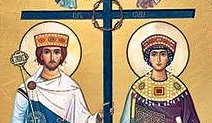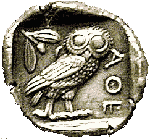| i) Emperors who became Saints (included in the Orthodox Synaxarium) |
Constantine I the Great (306-337)
Why a saint: With the Edict of Milan (313), he stopped persecutions against Christians. By convoking the Council of Nicea (325), he began the unofficial sponsorship of Christianity by the state, which was a major factor in the spread of the faith. "Equal to the Apostles", the most popular saint of the Greek-orthodox world. Objection: All his life he was a follower of the cult of the Sun. He was baptized a little before his death. Commemorated on: May 21, along with his mother Helena |
Theodosius I (the Great)(379-395)
Why a saint: He consolidated the conversion to Christianity. In February 380, issued an edict (with Gratian) declaring that all subjects of the Empire should profess the Orthodox faith. He convened the 2nd Ecumenical Council. He took severe measures against the pagans destroying temples and persecuting non-Christians. He put an end to the Olympic games. Objection: Ruthless against pagans. His policies caused the destruction of most monuments and treasures of the ancient Greek civilisation. He ordered the slaughter of 7000 spectators in the Hippodrome of Thessaloniki. Commemorated on: January 17 |
Theodosius II (the Small)(408-450)
Why a saint: There is no obvious reason for him to be a saint other than he continued the efforts of his father (Arcadius) and his grand-father (Theodosius the Great) to exterminate the last remnants of the ancient -pagan- world. During his time, Constantinople was an austere and theocratic place under the influence of his sister and regent Pulcheria (a saint too) Objection: Apparently, his sainthood is a prime example of the continuation of the pagan apotheosis (of kings) in Christian times. Commemorated on: July 29 |
Marcian(450-457)
Why a saint: He convened the Council of Chalcedon (451) which established Christian Orthodoxy and is considered the watershed for Christology. He also built many churches and monasteries including the Vlahernai church. Objection: The real saint (and religiously overzealous) was his wife, empress Pulcheria who died a virgin. Commemorated on: February 17, along with his wife Pulcheria |
Leo I the Thracian(457-474)
Why a saint: He was a fierce enemy of the Monophysites. In 465 issued an edict commanding that only Orthodox Christians (of the Chalcedonean creed) had the right to be in public office. Most probably he became a saint because almost all his Christian predecessors were canonized too. Objection: His official name as a saint is Saint Leo Makellis the Great. “Makellis” was a derogative nickname of his, that did not survive historically, but apparently survived theologically. It means “slaughterer”. Commemorated on: January 20 |
Justinian I(527-565)
Why a saint: Hyperactive in religion matters as in all other areas. He is a saint basically because he was a great emperor, a defender of Orthodoxy (among other things, he closed the Academy of Athens) and because he built Hagia Sophia and the Monastery of Sina . He convened the 5th Ecumenical Counsil which condemned various heresies and censured the teachings of Origen. He pursued the conversion to Christianity of pagans in neighboring nations. Paganism in Byzantium was completely banished during his reign. Objection: In his last years, he succumbed to the heresy of aphthartodocetism (an extreme form of Monophysitism that claimed that it was not possible that the body of Jesus have suffered). Commemorated on: November 14, along with his wife Theodora |
Constantine IV (the New)(668-685)
Why a saint: He called the Sixth Ecumenical Council (aka the Third Council of Constantinople) from November of 680 until September of 681. Most of its 18 sittings were presided by Constantine himself. The council decreed that Christ had both a divine and human will that matched his two natures. This solved the controversy over monothelitism. Objection: It is not absolutely certain that this one is the other emperor named Constantine (in addition to the "Great" one) who is a saint. Some Greek synaxaria refer to his grand father Constantine III, son of Heraklios, who was on the throne for 6 months in 641. But there is no reason for the latter to be a saint except from the fact that his life and his reign were too short and, since he was popular, this might have moved the Byzantines. Commemorated on: September 3 |
Justinian II Rhinotmetos(685-695 & 705-711)
Why a saint: He convened the Quinisext Council (Πενθέκτη) in the palace of Constantinople ("Εν Τρούλω") to ratify 102 disciplinary canons from the Fifth and Sixth Ecumenical Councils that had been inactive. This was also important because it made possible the reconciliation, for a while, of the differences between the western and the eastern churches. Objection: A weird choice for a saint. He was one of the most tyrannic and brutal emperors of Byzantium, especially in his second term. Commemorated on: August 2 |
Theodora(842-855)
Why a saint: She was strongly iconophile and after the death of her husband Theophilos overrode his iconoclastic policies to finally restore veneration of icons in the Byzantine Empire. Thus, the worst internal conflict in the history of Byzantium ended. Objection: - Commemorated on: February 11 |
Nikephoros II Phocas(963-969)
Why a saint: He is a saint mainly because he supported his friend Athanasius the Athonite to found the monastic community on Mount Athos. Furthermore, as a general in 961, he took back Crete from the Muslims. Later, he liberated Cyprus and many areas in Minor Asia. All his wars had a strong religious character. Objection: He was one of the cruelest warriors of Byzantine history. He had the nickname "the white death of the Saracens" because of his brutality against Muslims but also against non-cooperating Christians. Commemorated on: December 11 |
John III Doukas Vatatzes(1221-1254)
Why a saint: He was a kind, pious, humble and efficient ruler in difficult times. Objection: There is nothing dramatic in his reign that would justify his sainthood (but it appears to have been closer to holiness that any other person in this list of emperors/saints ) Commemorated on: His memory is especially venerated in Didymoteichon, on November 4. |
––– ♦ –––
| ii) Emperors whose Saintly Status is unclear |
Irene of Athens(797-802)
She was responsible for the restoration of icons and the ending of the first period of iconoclasm. That was big, but she had been otherwise too mean to be canonized (blinding her own son to seize the throne). She is mentioned by some sources as a saint but she is not included in the synaxarium |
Manuel I Komnenos(1143-1180)
He was very powerful, very popular, very successful. He became a monk before his death and took the name Matthew. He is not mentioned in synaxaria but there is an akolouthia in his memory and a veneration day. Commemorated on: July 21 |
John IV Laskaris(1204-1261)
He was 11 years old when he was deposed and blinded by Michael VIII. He spent the rest of his life as monk, under the name Joasaph. After his death in 1305, he was recognized as a saint, whose memory was revered in Constantinople in the 14th century. Apparently the Byzantines were sorry for the fate of am innocent kid who had been the last emperor of a dynasty of good rulers and honest men. He is not mentioned in synaxarium today. |
Constantine XI Palaiologos(1449-1453)
The last Byzantine emperor. He was killed by the Turks defending the walls of the City. Normally, that would have been enough to make him a martyr, but he has not been officially recognized as a saint. One of the reasons for this was that during the Ottoman rule, any effort to officially beatify Constantine XI would have been seen as an act of rebellion. Commemorated on: May 29 (not officially) |




















